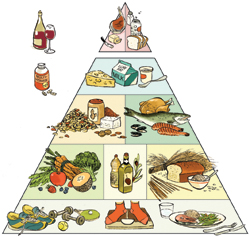The Ideal Body Weight
There are many ways to determine one’s ideal body weight. Without going into complicated mathematics, the ideal weight can be calculated using the following method:
100 lbs (for the first 5 feet) + 5lbs for each additional inch for women
110 lbs (for the first 5 feet) + 5 lbs for each additional inch for men.
The ideal weight for a woman at 5 feet 5.5 inches, for example, would be
100 lbs + 5.5 * 5 lbs = 127.5 lbs.
Myths
When it comes to maintaining an ideal weight, myths abound. Many people believe in sweating their pants off in a gym, others starving themselves with purely low fat, low carb menus. Still others swear by fad diet plans. Maintaining an ideal weight isn’t about any of the above. It is about making relatively healthy choices in life, with the focus on relative. Often, the choices come at low or no cost to you.
You are what you eat. If you eat a lot of junk food, fat will creep up on you. There is no mistake about that. Does that mean, though, that you should strictly adhere to a low fat, low calorie, low carb diet and cut everything else out? Not necessarily.
Red meat, such as beef, has a high content of saturated fat, which is associated with cardiovascular diseases. Regular consumption of red meat can be unhealthy. However, those trying to eat a leaner diet should also keep in mind that red meat is a good source of complete protein and iron. Abstaining from it could cause serious conditions such as iron deficiency and anemia.
The trick then, is not to fight the “absolute” evil, but rather, to pick the relatively less evil option whenever you can.
Your weight is influenced by how active you are throughout the day. Generally, the more active you are, the less likely you are overweight. Finding an exercise routine that works for you—one you can stick to long term—is vital. Obviously, if you signed up for power work-outs in a gym but pushed yourself so hard that you got fed up with it and never went there again, gym membership is not going to do you any good. If you find it easier to commit to a brisk 20-minute walk in your neighborhood, by all means do just that. You may actually end up losing more weight if you can do it every day.
Again, there is no absolute right. You just pick whatever is the lesser evil, as long as it comes natural to you: when you can sit, do not lie; when you can stand, do not sit; when you can walk around, do not sit still; when you can take the stairs, do not use the escalator or elevator. The list goes on and on.
Thirdly, losing weight and/or maintaining a healthy diet does not have to be costly. You can, for instance, cut down on your food costs by making it a habit to never buy meat except when it’s on sale. Every grocery chain will have weekly meat sales to draw people into the store. Watch the ad circulars for sales. If sales info is not available, talk to the meat clerk and ask if he knows what cuts will be on sale the following week and what time they mark down the day’s meat. Stop by at that time. And finally, when you can get a good deal on lean cuts of meat, buy in bulk, and freeze what you won’t be using right away.
More tips on eating healthy later.


